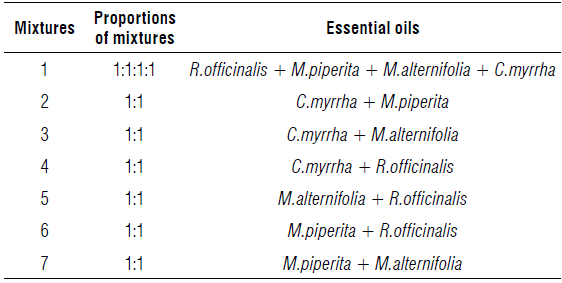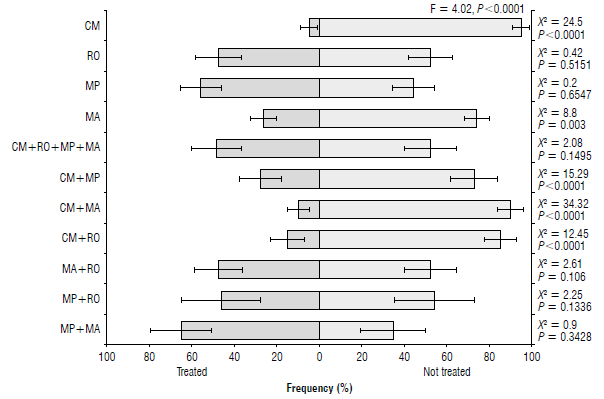Introduction
The two-spotted spider mite, Tetranychus urticae Koch (Acari: Tetranychidae), is a polyphagous cosmopolitan pest responsible for serious damage to crops of economic interest in irrigated and protected cultivation systems worldwide (Migeon et al., 2019). The considerable negative effect of this pest on agriculture is related to its short biological cycle, high fertility rate and ability to cause injuries (Araújo et al., 2020). The main form of control is through the application of synthetic acaricides, widely used throughout Brazil (Araújo et al, 2020). The indiscriminate use of these synthetic products has favored the selection of resistant populations (Monteiro et al., 2015). T. urticae is currently resistant to 95 active ingredients with different modes of action, with records of more than 500 cases of resistant populations in various regions of the world and Brazil (Mota-Sanchez & Wise, 2021). Additionally, these acaricides can cause other undesirable effects, such as biological imbalance due to the elimination of beneficial organisms (Efrom et al., 2012). Thus, there is a need to look for control alternatives that can minimize such problems. To this end, researchers have been investigating new acaricides based on essential oils extracted from plants. The literature reports the effects of essential oils and their constituents on several arthropods, including T. urticae (Mar et al., 2018). However, few studies have addressed the acaricidal properties of essential oils and their mixtures for the management of T. urticae in protected cultivation (Born et al., 2018).
This study evaluated the residual contact toxicity and the repelling effect of the essential oils of Rosmarinus officinalis (Lamiaceae), Mentha piperita (Lamiaceae), Melaleuca alternifolia (Myrtaceae) and Commiphora myrrha (Burseraceae) and their mixtures on adult females of T. urticae under laboratory conditions and protected cultivation.
Materials and methods
Biological material
The adult females of T. urticae were bred on jack bean (Canavalia ensiformis L. (Fabaceae) plants in air-conditioned rooms with 25±1°C, 65±3% relative humidity and 12 h photoperiod in the Núcleo de Desenvolvimento Científico e Tecnológico em Manejo de Pragas e Doenças (NUDE-MAFI) at the Centro de Ciências Agrárias e Engenharia at Universidade Federal do Espírito Santo - Campus de Alegre, Espírito Santo, Brazil (CCAE-UFES).
Obtaining the essential oils
Essential oils with 100% purity were purchased from the company Casa do Saboeiro® Ltda, located at Rio Grande do Sul, São Paulo, Brazil.
Chemical characterization of essential oils
The essential oils were analyzed by gas chromatography with flame ionization detector (GC/FID) (GC-2010 Plus, Shimadzu, Tokyo, Japan) and gas chromatography coupled to mass spectrometry (GC/MS) (QP2010 Plus, Shimadzu, Tokyo, Japan) adapting the methodology of Souza et al. (2017). The following chromatographic conditions were used in both analyses: capillary column of fused silica (30 m x 0.25 mm) with stationary phase Rtx®-5MS (0.25 μm of film thickness); N2 (in GC/FID analysis) and He (in GC/MS analysis) as carrier gas with a flow rate of 3.0 ml/ min; the oven temperature followed a schedule in which it remained at an initial temperature of 40°C for 3 min and then gradually increased by 3°C/min until it reached 240°C, maintaining this temperature for 5 min, with an injector temperature of 250°C, detector temperature of 280°C and split ratio of 1:30. GC/MS analysis was performed on equipment GCMS-QP2010 Plus with detector and AOC-5000 sample injection system (Shimadzu, Tokyo, Japan) operated by electronic impact with impact energy of 70 eV, scan speed of 1,000, scanning interval of 0.50 fragments sec-1, and detected fragments from 29 to 400 m/z.
The identification of the chemical components of the oils was carried out by comparing their mass spectra with those available in the Willey 7, NIST 05, NIST 05s teak spectrum database with the co-injection of standards and by the retention indexes (RI). To calculate the RI, a mixture of linear n-alkanes (C7 to C40) was used as standard. The calculated RI for each compound was compared with values reported in the literature (Adams, 2007).
Preparation of mixtures of essential oils
The blends of the essential oils of R. officinalis, M.piperita, M. alternifolia and C. myrrha were made in the following proportion (Tab. 1), according to the methodology proposed by Pavela (2015).
Residual contact toxicity test of essential oils and mixtures
The residual contact toxicity of essential oils was evaluated on adult females of T. urticae using the methodology adapted from Paes et al. (2015). Jack bean leaf discs with a 4.5 cm diameter were placed on a 6.5 cm diameter acrylic box with a 5 mm deep layer of a 1% ml L-1 agar-water solution; Tween 80 was diluted to a concentration of 0.05% (ml L-1). To spray the treatments (control (distilled water + Tween 80), essential oil + distilled water + Tween 80, and mixtures of essential oils at a 1:1 proportion + distilled water + Tween 80 at a concentration of 2% (ml L-1)) an airbrush calibrated to a pressure of 15 N m-2 was used, at a distance of 30 cm. Each leaf disc was infested with 20 adult female mites aged 5 d, placed on the underside of the leaf. For each essential oil, five replicates were performed, totaling 100 mites per treatment. The concentration of treatments was in accordance with Ataide et al. (2020).
The test was conducted in an air-conditioned chamber (temperature of 25±1°C, relative humidity of 70±10% and photoperiod of 12 h). After 24 h, adult female mortality was assessed. To confirm mortality, the mites were lightly touched with a fine bristle brush (number 00) on the dorsal area. Immobile mites were considered dead.
Lethal concentration estimate
The lethal concentration (LC) was estimated with essential oils that reached a mortality rate above 80%, calculated by PROBIT analysis (Finney, 1971). Therefore, the lethal concentration of myrrh essential oil was estimated on adult females of T. urticae. For this, seven concentrations were used: 0.0, 0.3, 0.5, 0.8, 1.2, 1.5, and 2.0% (ml L-1) of myrrh essential oil, with the lower limit (concentration that causes the death of about 10% of T. urticae) and higher (concentration that causes the death of about 90% of T. urticae) determined by preliminary tests. In the control, distilled water + Tween 80 was used; for the treatments, essential oil + distilled water + Tween 80 was used. This step of the test was performed according to the procedures adopted in the toxicity test. Mortality was assessed after 24 h.
Repellency test of essential oils and mixtures
The double choice chance method adapted from Aslan et al. (2004) was carried out using Petri dishes of 10 cm in diameter containing culture medium at 1% ml L-1 (water + agar). Two leaf discs of C. ensiformis (2.5 cm in diameter, treated and untreated) were placed in each Petri dish, joined by a glass coverslip (18 mm). The experiment was carried out in triplicate, with six replicates with 20 T. urticae, totaling 120 mites per treatment. Each treated leaf disc was immersed according to the proposed treatments: distilled water + essential oil + Tween 80 and the mixtures of essential oils at a 1:1 proportion + distilled water + Tween 80 at a concentration of 2% (ml L-1). The untreated discs were immersed in distilled water + Tween 80. After immersion, the leaf discs were placed to dry for 20 min at room temperature. Subsequently, 20 T. urticae adult females of 5 d of age were placed on the underside of the leaf in the center of the coverslip with the aid of a fine-bristle brush (number 00). The treatments were placed in an air-conditioned room (temperature of 25±1°C, relative humidity of 70±10% and photoperiod of 12 h). After 72 h, the number of mites present in the treated and untreated discs was counted. The mites present on the untreated discs were considered to be repelled by the essential oil.
Toxicity test by residual contact in protected cultivation
The experiment was carried out in a protected cultivation at the Centro de Ciências Agrárias e Engenharia at Universidade Federal do Espírito Santo (CCAE-UFES) located in Alegre, ES, Brazil. The upper part of the greenhouse of the protected cultivation was covered with 150 μm plastic film and the side was covered with Optinet 50 mesh anti-aphid screen.
Jack beans (Canavalia ensiformis var. Coriacea (Biblioth. Robot) (Fabaceae) were sown manually and deposited in disposable cups (100 ml) containing Provaso® (Agrosolo, Conceição da Barra, ES, Brazil) organic substrate. Irrigation was performed daily, with each plant receiving the same amount of water for irrigation. When the C. ensiformis plants reached the age of 14 d, uniform plants were selected. After 10 d, the inoculation of 5,000 adult females of T. urticae was carried out. Ten d after inoculation, spraying was performed with an airbrush calibrated at a pressure of 15 N m-2 at a distance of approximately 30 cm from C. ensiformis plants, with a volume of 5 ml of the syrup of the aforementioned treatments.
Approximately 1 ml was sprayed on the upper and lower sides of each leaf of C. ensiformis; the treatments were as follows: distilled water + Tween 80 (control), C. myrrha essential oil + distilled water + Tween 80 (treatment) at LC95 and the acaricide fenpyroximate from the chemical group pyrazole + distilled water (positive treatment) at the commercial concentration.
The experimental design was in randomized blocks, with three treatments, five replicates and five blocks. Each block consisted of 15 plants, with five plants from each treatment arranged at random. After 24 h of exposure to treatments, the total number of live and dead mites was counted. To confirm mortality, the mites were lightly touched with a fine bristle brush (number 00); immobile mites were considered dead. The temperature of the protected cultivation varied between 25°C and 38°C, and the humidity between 40% and 85%.
Data analysis
For the acute toxicity test, an ANOVA was applied and then the means were compared by the Scott-Knott test (P<0.05). For the pair test, the Pearson's chi-square test was applied. The concentration-response curves as well as the lethal concentration (LC50) of the essential oil of myrrh were subjected to PROBIT analysis (Finney, 1971). In the test in protected cultivation, a randomized block design was used, with means compared by the Tukey's test (P≤0.05). All analyzes were performed using R software (R Development Core Team, 2010).
Results
Chemical characterization of essential oils
In the gas chromatography analysis with flame ionization detector (GC/FID), eight constituents were identified in the essential oil of R. officinalis, in which eucalyptol (49.66%), α-Pinene (17.08%) and camphor (14.79%) were the main ones. Fourteen constituents were identified in the essential oil of M. alternifolia, with terpinen-4-ol (48.93%) and Y-Terpinene (20.88%) being the main ones. Nine constituents were found in the essential oil of M. piperita, in which menthol (48.53%) and menthone (24.25%) were the main ones. Two constituents were identified in the essential oil of C. myrrha, with benzyl benzoate (97.71%) being the main one (Tab. 2).
TABLE 2 Chromatographic analysis of the essential oils of R. officinalis, M. alternifolia, M. piperita, and C. myrrha.
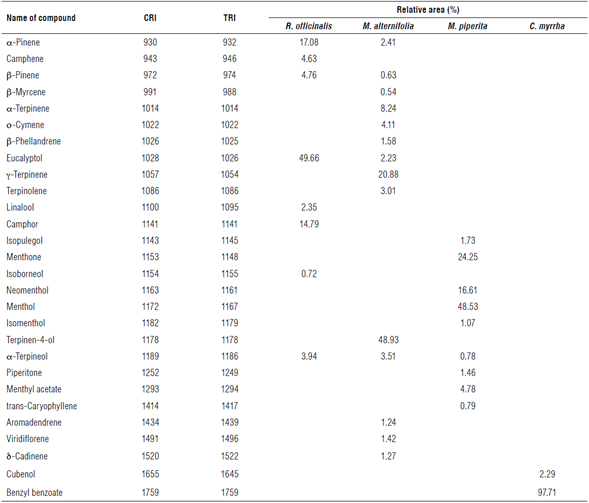
The compounds were identified by LTPRI index (GC/FID) and mass spectrometry (GC/MS) using an Rtx®-5MS column. CRI - retention index calculated from data obtained by sampling of saturated n-alkanes (C7-C40). TRI - tabulated retention index (Adams, 2007). Compounds with relative areas >0.5% were identified.
Residual contact toxicity test of essential oils and mixtures
The residual contact toxicity of essential oils and their mixtures against adult females of T. urticae is shown in Figure 1. The essential oil C. myrrha exhibited 95% mortality (F11,48 = 119.12; P<0.001), and the mixtures R. officinalis + M. piperita + M. alternifolia + C. myrrha, C. myrrha + M. piperita, and C. myrrha + M. alternifolia showed 68%, 60% and 36% (F11,48 = 119.12; P<0.001).
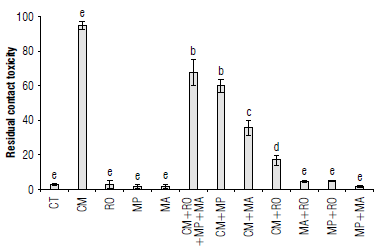
FIGURE 1 Means (± standard error) of mortality of T. urticae females at a temperature of 25±2°C, relative humidity of 70±10%, and a photope-riod of 12 h by essential oil mixtures; CT - control, CM - C. myrrha, RO - R. officinalis, MP - M piperita, MA - M. alternifolia. Equal letters do not indicate statistically significant differences from each other according to the Scott-Knott test at 5% probability.
Lethal concentration
The lethal concentration of the essential oil of C. myrrha showed an LC95 of 1.6 ml L-1 and an LC50 of 0.55 ml L-1 (Tab. 3).
Repellency test of essential oils and mixtures
The repellency effect of essential oils and their mixtures in adult females of T. urticae is shown in Figure 2. Among the essential oils and their mixtures, the essential oils of C. myrrha and M. alternifolia showed 95 and 70% of repellency, respectively (F10 89= 4.020; P<0.001). Mixtures of C. myrrha + M. alternifolia, C. myrrha + M. piperita, and C. myrrha + R. officinalis provided repellency of 85, 74 and 73%, respectively (F10>89 = 4.020; P<0.001).
Toxicity test by residual contact in protected cultivation
The essential oil of C. myrrha showed 93% toxicity against adult females of T. urticae in protected cultivation, whereas the fenpyroximate showed 80% toxicity (F2, 8 = 545.24; P<0.001) (Fig. 3).
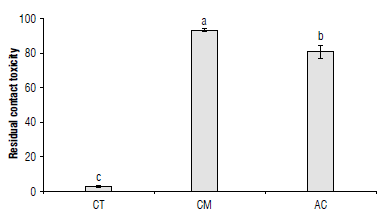
FIGURE 3 Means (± standard error) of mortality of females T. urticae in protected cultivation by the application of essential oil and acaricide; CT - control, CM - C. myrrha and AC - acaricide (fenpyroximate); equal letters indicate treatments that do not differ statistically from each other according to the Tukey's test at 5% probability.
Discussion
The major constituent identified in the essential oil of C. myrrha was benzyl benzoate (97.71%) which differed from the major constituents identified by Mohamed et al. (2014). The major constituents in the essential oil of M. piperita were menthol (48.53%) and menthone (24.25%), which were the same major constituents found by Kizil et al. (2010) and Moghaddam et al. (2013). The major constituents found in M. alternifolia were terpinen-γ-ol (48.93%) and γ-Terpinene (20.88%), with the same major constituents found by Zhang et al. (2018) and Silva et al. (2019). In the essential oil of R. officinalis, the major constituents found were eucalyptol (49.66%), α-Pinene (17.08%) and camphor (14.79%); similar results were found by Borges et al. (2018) and Jardak et al. (2017) for constituents α-Pinene and camphor.
This study found that the essential oil of C. myrrha showed residual contact toxicity against adult females of T. urticae, exhibiting an LC50 of 0.55 ml L"1. Araújo et al. (2012) found that the essential oil of Piper aduncum, Piperaceae showed an LC50of 7.17 μl m A on adults of T. urticae.Ribeiro et al. (2019) evaluated four different Citrus sp. essential oils on T. urticae. Of these, the essential oil of Citrus limon, Rutaceae showed an LC50 of 25.18 μl ml-1 L. Essential oils that show efficiency in the control of pest arthropods by residual contact can penetrate the tegument layers (Enan, 2001). Consequently, since essential oils are made up of several substances, they can act in more than one place exhibiting a neurotoxic action (Isman, 2006).
The mixtures of R. officinalis + M. piperita + M. alternifolia + C. myrrha and C. myrrha + M. piperita at a 1:1 ratio showed promising results in terms of the toxic effect from residual contact on adult females of T. urticae with intermediate toxicity, which resulted in an additive interaction. Although we did not find synergistic effects, this type of interaction has been described by Mwaiko (1992) for mixtures of bark essential oils from two species of Citrus (C. limon, C. aurantium, Rutaceae) against Culex pipiens L. (Diptera: Culicidae) larvae. Benelli et al. (2017) evaluated the acute toxicity of binary mixtures of essential oils of the Apiaceae family on the larvae of C. quinquefasciatus, an important vector of filariasis, and found that Trachysper-mum ammi Apiaceae + Pimpinella anisum, Apiaceae (1:2 ratio) and S. olusatrum + P. anisum (1:1 ratio) were the most toxic to the pest.
The repellent effect of essential oils in integrated pest management is important; as these substances keep pests away from the crop, damage is minimized (Da Cámara et al., 2015). The results of the repellency tests suggest that the essential oils of C. myrrha and M. alternifolia and the mixtures of C. myrrha + M. piperita, C. myrrha + M. alternifolia and C. myrrha + R. officinalis showed a repellent effect on females of T. urticae. In previous studies, Araújo Júnior et al. (2010) found that the essential oils of C. aurantium and C. sinensis var. Mimo showed repellency of T. urticae at a concentration below 2.5%, while the essential oil of C. sinensis var. Pear had a neutral effect. Sararit and Auamcharoen (2020) observed that the essential oils of Anethum graveolens and Allium sativum exhibited repellency of adult females of T. urticae at concentrations of 15 to 20%. Farahani et al. (2020) noted that essential oils of Thymus daenensis (Lamiaceae), Satureja khuzestanica (Lamiaceae), and Satureja bakhtiarica (Lamiaceae) showed repellency against adult T. urticae. The repelling action of essential oils triggers an escape behavior of mites, detected by the olfactory sensilla present in the legs (Missbach et al, 2014; Oliveira et al, 2018).
The tests in protected cultivation confirmed the laboratory observations that the essential oil of C. myrrha was toxic to adult females of T. urticae. In a study carried out to avoid the spread of mites in a greenhouse, Da Cámara et al. (2015) observed that the essential oils of C. sinensis and C. aurantium were repellent to T. urticae. The essential oil of C. aurantium, in particular, prevented the dispersion of the pest for a period of 1 week. In a greenhouse trial, Potenza et al. (2006) observed toxicity by contact of the aqueous extract of Allamanda cathartica (Apocynaceae), Dieffenbachia brasiliensis (Araceae), Cenchrus purpureus (Schumach.) Morrone (Poaceae), Annona squamosa (Annonaceae), Ruta graveolens (Rutaceae), Sonchus oleraceus (Asteraceae), Spondias purpurea (Anacardiaceae), Lyte-chinus variegatus (Euphorbiaceae), Impatiens walleriana (Balsaminaceae), Stryphnodendron adstringens (Fabaceae), Solanum melongena (Solanaceae), Campsiandra angustifolia var. angustifolia (Fabaceae), and Allium (Amaryllidaceae) on T. urticae. However, only plants with D. brasiliensis, R. graveolens, A. squamosa, S. oleraceus, I. walleriana, A. angustifolia, S. adstringens, and S. melongena promoted a significant reduction in the population of T. urticae of between 60 and 86%. In another study, EcoTrol (containing 10% rosemary oil), a pesticide based on the essential oil of rosemary, proved to be efficient in the control of T. urticae in a greenhouse (Miresmailli & Isman, 2006).
Conclusions
The essential oil of C. myrrha and the binary and quaternary mixtures C. myrrha + M. piperita and R. officinalis + M. piperita + M. alternifolia + C. myrrha, showed significant mortality in this study. The essential oil of C. myrrha, in turn, showed results in a protected cultivation similar to those obtained with the application of commercial acaricides for the control of T. urticae in orchards and in a protected system in Brazil. This study shows the feasibility of using a botanical acaricide with C. myrrha essential oil as an active ingredient for the management of T. urticae. However, for large-scale use, studies to reduce essential oil production costs and the effects on non-target organisms are needed.













